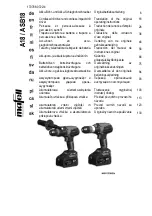
2
or storing power tools.
Such preventive safety
measures reduce the risk of starting the power tool
accidentally.
■
Store idle power tools out of the reach of
children and do not allow persons unfamiliar
with the power tool or these instructions to
operate the power tool.
Power tools are dangerous
in the hands of untrained users.
■
Maintain power tools. Check for misalignment
or binding of moving parts, breakage of parts
and any other condition that may affect the
power tool’s operation. If damaged, have the
power tool repaired before use.
Many accidents
are caused by poorly maintained power tools.
■
Keep cutting tools sharp and clean.
Properly
maintained cutting tools with sharp cutting edges
are less likely to bind and are easier to control.
■
Use the power tool, accessories and tool bits
etc, in accordance with these instructions,
taking into account the working conditions and
the work to be performed.
Use of the power tool
for operations different from those intended could
result in a hazardous situation.
5) BATTERY TOOL USE AND CARE
■
Recharge only with the charger specified by the
manufacturer.
A charger that is suitable for one
type of battery pack may create a risk of fire when
used with another battery pack.
■
Use power tools only with specifically
designated battery packs.
Use of any other
battery packs may create a risk of injury and fire.
■
When battery pack is not in use, keep it away
from other metal objects, like paper clips, coins,
keys, nails, screws or other small metal objects
that can make a connection from one terminal
to another.
Shorting the battery terminals together
may cause burns or a fire.
■
Under abusive conditions, liquid may be ejected
from the battery; avoid contact. If contact
accidentally occurs, flush with water. If liquid
contacts eyes, additionally seek medical help.
Liquid ejected from the battery may cause irritation
or burns.
6) SERVICE
■
Have your power tool serviced by a qualified
repair person using only identical replacement
parts.
This will ensure that the safety of the power
tool is maintained.
HAMMER DRILL SAFETY WARNINGS
■
Wear ear protectors when impact drilling.
Exposure
to noise can cause hearing loss.
■
Use auxiliary handle(s), if supplied with the tool.
Loss of control can cause personal injury.
■
Hold power tool by insulated gripping surfaces,
when performing an operation where the cutting
accessory may contact hidden wiring.
Cutting
accessory contacting a “live” wire may make exposed
metal parts of the power tool “live” and could give the
operator an electric shock.
■
Hold power tool by insulated gripping surfaces,
when performing an operation where the fastener
may contact hidden wiring.
Fasteners contacting a
“live” wire may make exposed metal parts of the power
tool “live” and could give the operator an electric shock.
■
Do not operate on materials (e.g., asbestos) that
present a health hazard.
■
Switch off the product immediately if the bit stalls. Do
not switch on the product again while the bit is stalled,
as doing so could trigger a sudden recoil with a high
reactive force. Determine why the bit stalled and rectify
this, paying heed to the safety instructions.
The possible causes may be:
–
it is tilted in the workpiece
–
it has pierced the workpiece
–
the product is overloaded
■
Sawdust and splinters must not be removed while the
product is running.
■
When working in walls, ceilings, or floors, avoid
electrical cables and gas or water pipes.
■
Secure your workpiece with a clamping device.
WARNING
The product is not intended for use by persons (including
children) with reduced physical, sensory or mental
capabilities, or lack of experience and knowledge,
unless they have been given supervision or instruction
concerning use of the product by a person responsible
for their safety.
Children should be supervised to ensure that they do not
play with the product.
TRANSPORTING LITHIUM BATTERIES
Transport the battery in accordance with local and national
provisions and regulations.
Follow all special requirements on packaging and labelling
when transporting batteries by a third party. Ensure that
no batteries can come in contact with other batteries
or conductive materials while in transport by protecting
exposed connectors with insulating, non-conductive caps
or tape. Do not transport batteries that are cracked or
leaking. Check with the forwarding company for further
advice.
RESIDUAL RISKS
Even when the product is used as prescribed, it is still
impossible to completely eliminate certain residual risk
factors. The operator should pay particular and additional
attention to these points in order to reduce the risk of
serious personal injury.
Summary of Contents for R18PD3
Page 1: ...ORIGINAL INSTRUCTIONS Hammer Drill R18PD3...
Page 8: ...6 I I I 4 I I I 8 I I I 1 2 I I I 1 6 I I I 2 0 I I I 24 1 2 1 2 20170425v1...
Page 9: ...5 3...
Page 10: ...7 4...
Page 11: ...8...
Page 12: ......
































